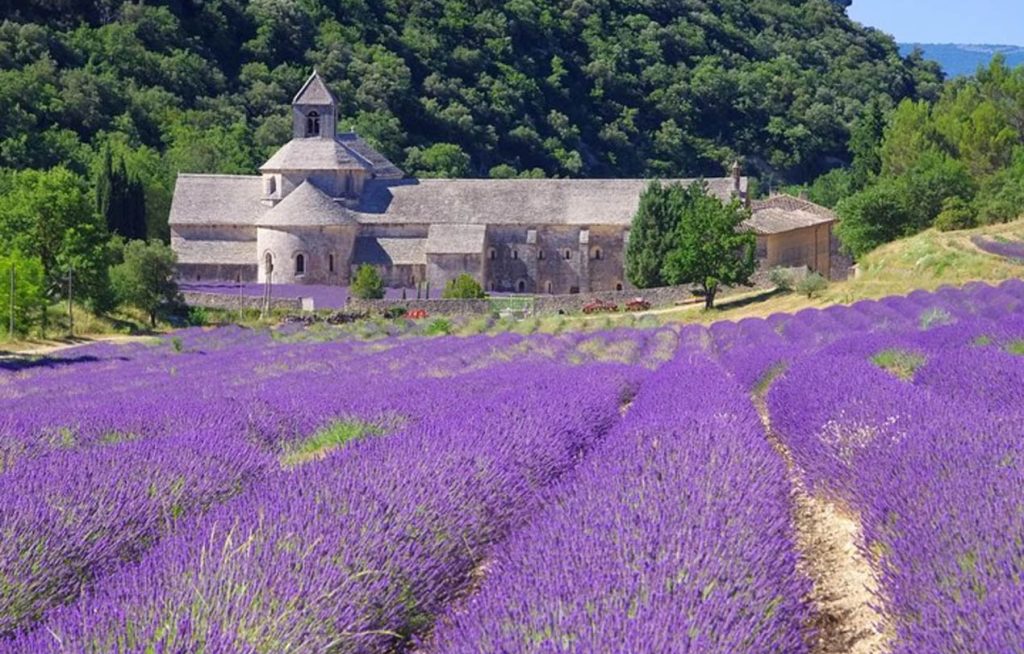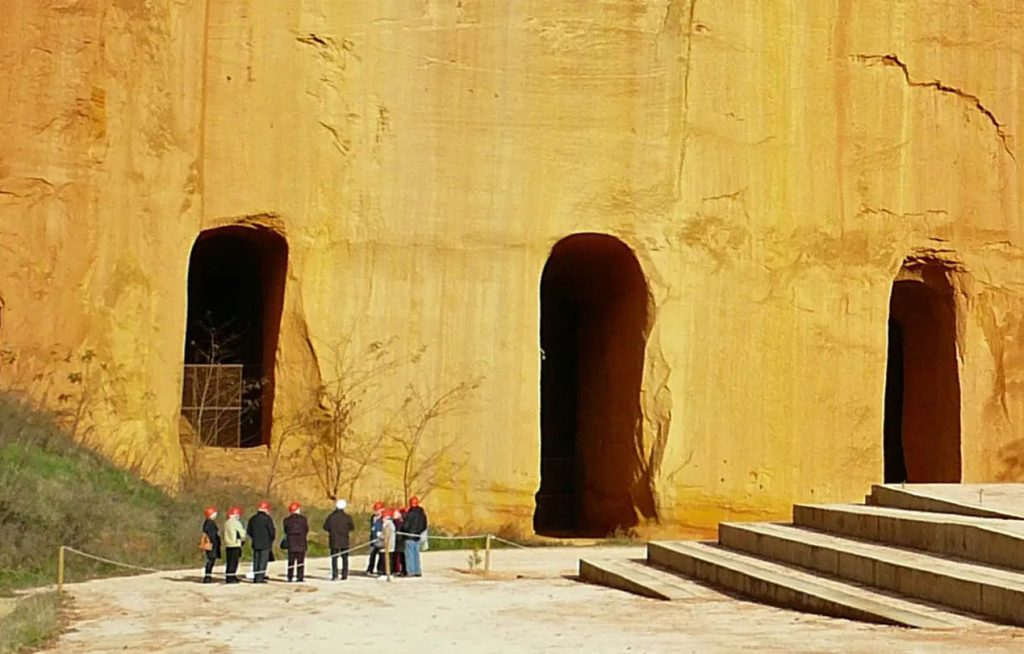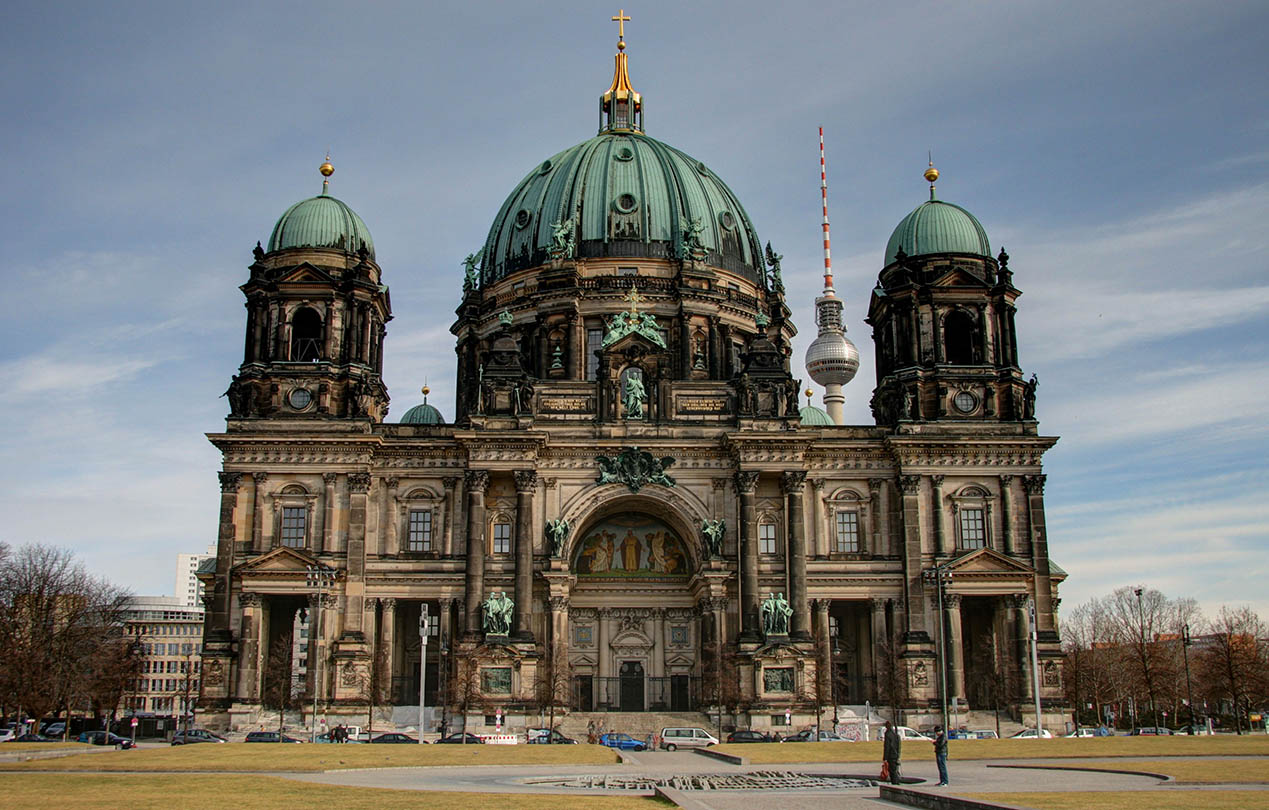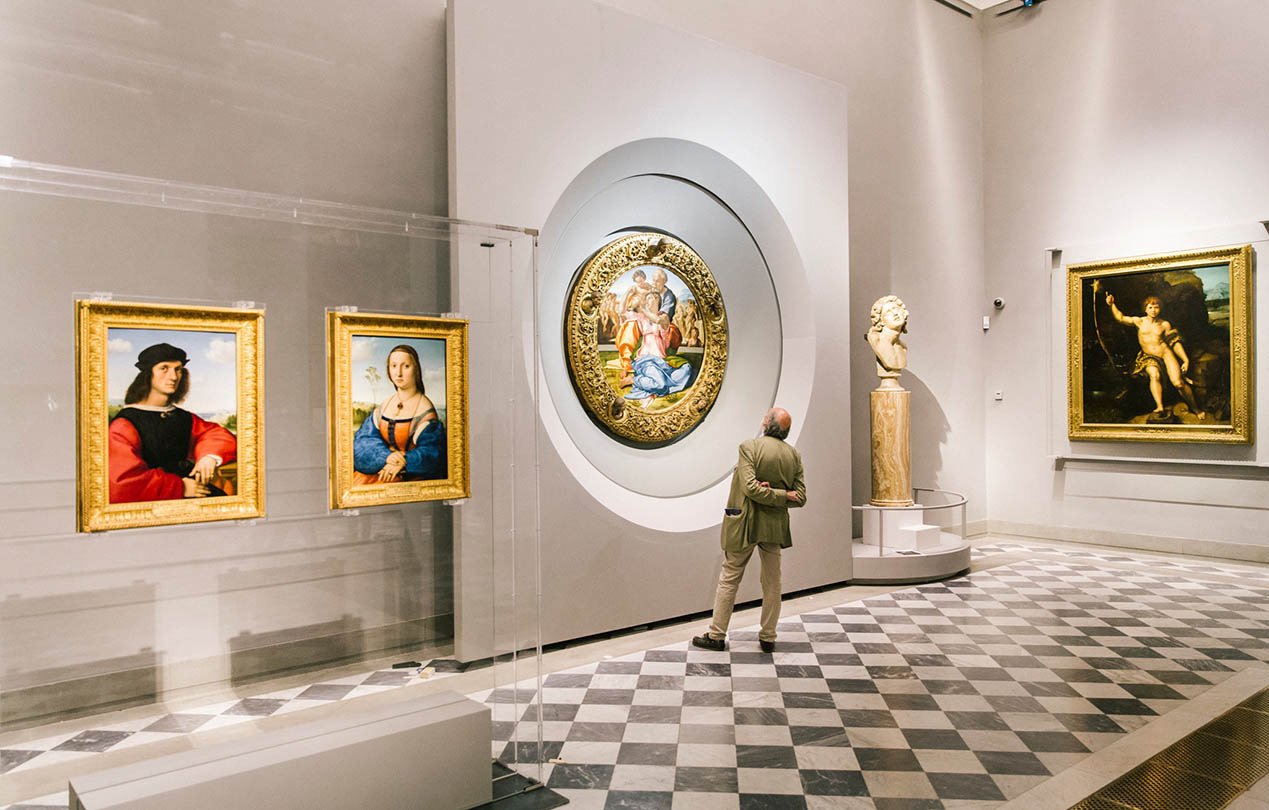Avignon
Departure under a sky streaked with airplane trails. For me, each one a possible departure, infinite dreams… For the girls, much more down-to-earth: “It’s too ugly!”
Arrival in Avignon in the early afternoon. We park outside the city, by the Rhône, to get a panoramic view: the famous bridge, the medieval city, and Mont Ventoux in the background.
Even before entering the old town, Avignon’s high ramparts loom before us. This lace-like stone wall, 4330 meters long, punctuated by 33 towers and 50 turrets, is the largest preserved wall in Europe from the late Middle Ages.
We head towards the Palace of the Popes, careful not to be knocked out by an ancient stone!
The Palace of the Popes
We emerge onto the immense square of the Palace, where the entrance to the imposing PALACE OF THE POPES is located. There isn’t too much crowd yet on this April weekend. Due to security measures, bags are checked, pockets emptied, and we pass through X-rays. There is a free cloakroom available after the check.
In the early 14th century, civil war in Italy created an atmosphere of insecurity that prevented the Sovereign Pontiff from living in Rome. In 1305, Pope Clement V arrived in Avignon and made the city the new, albeit temporary, seat of the papacy.
His successor, John XXII, remained there. The next pope, Benedict XII, decided to build in Avignon a building, part monastery, part fortress, known as the Old Palace. This Palace of the Popes, begun in 1335, would surpass in architectural beauty anything the pontiff had imagined. Later, Clement VI added new extensions, known as the New Palace, much more luxurious, and bought the city to solidify the papacy’s presence.
Worthy of a true princely residence, the papal seat was enriched with carpets and hangings from the Middle East. Corridors and vast ceremonial halls adorned with opulent sculptures and vibrant paintings by renowned artists. This display was meant to impress the world. It had to surpass the papal residence in Rome.
These two building popes erected, in less than 20 years, the largest Gothic palace: 15,000 square meters of floor space, equivalent in volume to 4 Gothic cathedrals.
Over 25 rooms are open to the public. The great chapel is one of the most impressive rooms: it measures 52 meters long, 16 meters wide, and 20 meters high. It hosted grand ceremonies such as papal coronations and funerals. The Grand Tinel with its vaulted wooden ceiling was the setting for papal feasts.
Access to the rooftops allows us to see the palace from another angle, as well as a magnificent panorama of the city and the Rhône.
Nine popes succeeded each other in Avignon. These popes feared returning to Italy, where unrest persisted. They also wanted to appease the kings of France, who used every argument to keep the papacy. Meanwhile, the people of Avignon rejoiced to see their city become the capital of the Church. The small city on the banks of the Rhône became a new Rome, a transformation that also propelled it into a leading commercial, political, and artistic center.
In Italy, Romans complained about what they called “papal treason.” Threatened with death by the great Roman families if they did not elect an Italian, the cardinals elected a pope in Rome: Urban VI. The election was invalidated by the French cardinals due to lack of freedom of choice. But the elected pope refused to resign, and the conclave then chose a new pope, CLEMENT VII, the “antipope” residing in Avignon.
Thus began the Great Western Schism, which divided Christianity for almost 40 years (1378-1417). From then on, half of Europe remained faithful to Rome, and the other half to the Avignon pope.
Upon Clement VII’s death, the Avignon cardinals elected BENEDICT XIII. But the Kingdom of France rejected his legitimacy, and the pope was besieged in the Palace for 5 years before finally escaping. However, he never abdicated.
In 1415, bishops gathered at the Council of Constance considered themselves “above” the pope and made the following decisions: Benedict XIII, the antipope, was deposed; the Roman pope abdicated to facilitate conflict resolution; and a new pope was elected in 1417 by a conclave supported by the Council of Constance. He returned to Rome, thereby ending the Great Western Schism.
The pont st-benezet, known as the pont d’avignon
After visiting the palace, we head to the famous bridge, known worldwide thanks to the famous nursery rhyme. We stroll down the streets lined with souvenir shops and some very friendly street artists.
According to legend, the bridge was built in the 12th century, at the initiative of a young shepherd, Bénezet, who received a divine order. Completed in 1185, the Romanesque bridge has 22 arches, is 947 meters long, and 4 meters wide. It spans the two arms of the Rhône.
It was a monumental feat for its time, the only stone bridge across the Rhône between Lyon and the Mediterranean Sea. A necessary crossing point linking Spain, Provence, and Italy, it attracted travelers, merchants, and industrialists. Taxes collected on goods made Avignon wealthy.
Unfortunately, numerous Rhône floods proved fatal to the bridge. Demolished by the waters and rebuilt several times, its use, too costly in repairs, was abandoned in the 17th century. Now only 4 arches remain.
We head upstream of the bridge to take a small boat that crosses the Rhône for free.
A pleasant path along the bank allows us to return peacefully to the parking lot.
We are getting closer to our destination tomorrow, Fontaine-de-Vaucluse, and camp in our van in the middle of the forest. Only the strong Mistral wind will disturb our tranquility!
Fontaine de vaucluse
The Sorgue is a lovely river with particularly pure and clear water. In Fontaine-de-Vaucluse, a developed path allows visitors to walk upstream to its source.
The source is the only point of outflow from an underground basin covering 1,100 km², collecting rainwater infiltrated from Mont Ventoux, the Vaucluse Mountains, the Albion Plateau, and Montagne de Lure. It gushes out at the foot of an immense 230-meter cliff that surrounds the abyss from which it emerges. In 1989, a robot reached the deepest known point of the siphon, at a depth of 308 meters.
As France’s primary source in terms of water volume discharged, Fontaine-de-Vaucluse ranks fifth globally among the largest springs.
Fontaine-de-Vaucluse presents a very different face depending on the seasons: calm and peaceful in summer, the Source cascades with bubbling water in spring during snowmelt, and in autumn during heavy precipitation, water levels gradually rise in the abyss, overflowing in cascades over the rocks.
The paper mill
This small free museum, along the path to the source, is a reconstruction of a mill producing paper using traditional techniques dating back to the 15th century.
Up until the mid-19th century, paper was made from old rags (linen, hemp, cotton).
Through a gearing system, the waterwheel rotates a belt that drives the camshaft, a cylindrical beam 6 meters long with protruding cams that strike the base of the mallet handle and lift it. The mallet, weighing 75 kg, then falls back under its own weight, crushing the rags in the vat.
The scraps of rags mixed with water pass through each of the five hammer vats, and after 24 to 36 hours, a coarse pulp is obtained. To refine it, the pulp is passed through a “Dutch vat” (invented in the 17th century), a tank where a cylinder with blades rotates, shredding the pulp for 1.5 hours while ensuring water circulation. This innovation allows for finer and smoother paper.
On the way back, we couldn’t resist trying a specialty of Vaucluse, the sacristan, a pastry made of twisted puff pastry sticks, sprinkled with almonds and sugar.
For us food lovers, it disappeared in no time. In fact, half of it is missing in the photo!
The Lavender Museum
We arrive at the parking lot at noon. The museum closes at 12:15 p.m. We settle down to eat peacefully, waiting for it to reopen at 2 p.m. The parking gate closes, but no one asks us to leave, nice!
We learn that in France, there are 2 types of lavender:
- True lavender grows above 800 meters in the dry mountains of Provence. It has a single stem with a flower at the end and reproduces by seed. It has a delicate fragrance, making it suitable for perfumery and medicinal properties. It takes 130 kg of flowers to obtain 1 liter of essential oil through distillation.
- Lavandin grows between 0 and 800 meters in altitude worldwide. It has 2 branches from the central stem, making it bushier. It is a hybrid and sterile, so it must be propagated by cuttings. It has a less subtle fragrance and no medicinal properties, mainly used industrially for perfuming cleaning products and detergents. It takes 40 kg of flowers to obtain 1 liter of lavandin essential oil.

Plant distillation involves passing steam through the flower to recover its essential oil. We discover a significant collection of lavender stills, from the 16th century to the present day.
Two very interesting documentaries show us agricultural work such as planting, harvesting, and distillation. Inhalers allow us to smell the fragrance of each variety, and indeed, the difference is very distinct! In summer, there are also many activities.
At the museum’s exit, there’s the inevitable shop where a salesperson immediately approaches to let you try different products (essential oils, ointments,…), but in a very friendly atmosphere. There’s no pressure to buy. Finally, a tasting of true lavender infusion is offered.
We won’t have the pleasure of seeing the lavender fields in bloom. Flowering begins in mid-June, and harvesting takes place from late July to late August.
the Village des Bories
Now heading to the Village des Bories, 4 km from Gordes.
Built on the slopes of Monts de Vaucluse, the bories or stone huts are the finest example of dry stone construction, typical of Mediterranean limestone plateaus.
The construction of these huts began in the 17th century and intensified in the 18th century, a period when rapid population growth forced peasants to seek new lands, often far from their original villages. The hills around Gordes were cleared, and thousands of tons of stones were extracted from the soil, providing new surfaces for cultivation and using these stones as the essential building material.
Dry stone technique involves assembling stones found abundantly during stone clearing without any binding material or mortar. The few openings faced south to prevent the mistral wind from entering the huts.
While these huts served as shelters for shepherds, storage, or granaries, here they also served as temporary and seasonal dwellings for farmers cultivating olive trees, vines, practicing animal husbandry, or sericulture (silkworm farming).
The bories were abandoned in the mid-19th century. Rediscovered in ruins in the 1960s, they were restored over 8 years by an individual who spared no effort to revive them.
This village is worth a visit, with its round, square, ovoid roofs, its huts with basic comfort but striking raw beauty.
Cars can park near the village, but campervans must park 1.7 km away in a designated free parking lot, with the rest of the journey on foot.
A quick detour to see Gordes from afar, one of the perched villages of Provence. With the photo in hand, we move away from civilization to find our bivouac for the evening. Passing through small forests where the imagination runs wild: here, two trolls frozen in a tender moment…
The Ochre Trail
The Ochre Trail is an open-air museum where visitors can discover the beauty and richness of this land, ochre. Access is through the village center and starts with a developed area over 50 meters offering a panoramic view. The walk continues with 350 steps… strollers are not recommended!
“Ochre” refers to clay colored by various iron oxides, giving it countless colors depending on the proportions of these oxides: yellow, beige, white, orange, violet, brown, etc., collide endlessly.
In nature, especially in Provence, this colored clay is associated with sand, which makes up to 90% of the raw rock, known as ochre sands.
After separating the sand from the colored clays, these clays become dyes that were highly sought after. Ochres have always been used by humans, even in cave paintings. They were used for paintings, coloring mortars and cement…
During the walk through cliffs and forests, a range of colors is revealed. The walk is punctuated by informative panels explaining the history of this Provencal land covered by water 230 million years ago and the geological upheavals that have since shaped the ochre sands.
In 1780, Jean Etienne Astier, a resident of the village of Roussillon, discovered that after treatment, ochre becomes an indestructible and non-toxic dye. He became France’s first ochre producer. Ochre mining industrialized at the end of the 18th century. In Vaucluse, open-pit quarries and exceptionally thick veins made mining very easy. Provencal production peaked in 1929 and declined with the advent of chemical dyes.
The trail is set up in former open-pit quarries. Since their abandonment, rain and wind continue to sculpt these cliffs, offering unusual and unexpected landscapes in France.
The Ochre Trail is not very long. The visit lasts 30 to 60 minutes depending on the chosen route.
For cars, there is the option to park in the center, just before or just after the village, in small paid parking lots.
For campervans, it is forbidden to drive through Roussillon. You must park in a large paid parking lot, 1 km before the village.
The village
Roussillon village, located in the heart of the world’s largest ochre deposit, offers a maze of alleyways and small squares with facades clearly tinted in various hues obtained from ochres. The shades range from light yellow to flamboyant red.
Ochre is used in the plastering of Provencal houses because it withstands heat and sun, but it also unexpectedly enters into the composition of certain products: the crust of certain cheeses, linoleum, kraft paper, cardboard, ceramics, rubber, or cosmetics.
This village is definitely worth a visit. We wandered randomly through the alleys and succumbed to its undeniable Provencal charm!
The Ochre Conservatory
Located 2 km from the village center, the conservatory is housed in the former Usine Mathieu, a company managed for over 30 years by Camille Mathieu, an ochre producer and mayor of Roussillon.
The buildings have been restored, and visitors can experience the different stages of processing raw material: removal of sands through stone canals (barrages and settling basins), drying of purified ochre in settling ponds, cutting into bricks which are later fired (the firing process determines different colors of ochre), and finally crushing, filtering, and packaging of pure ochre.
A slight disappointment for us as we discovered this place alone, as casual visitors. I think to fully appreciate this site, it’s better to plan a guided tour or educational workshop.
Bruoux Ochre Mines
From 1880 onwards, ochre from Luberon was also mined in quarries, dug into cliffs using carbide lamps, picks, and dynamite. Until 1950, over 50 km of galleries were excavated. Some galleries can reach heights of 15 m and widths of 3 m, with pillars of 6 m on each side due to the compactness of the ore.
Today, in the remains of the old mine, a 650-meter safe pathway has been set up. Impressive galleries, vaulted (to prevent ceiling collapse), in pointed or semi-circular arch shapes, form a true mineral cathedral. Some galleries have been flooded due to the unexpected piercing of an underground water table.
The visit is enjoyable and informative. It’s conducted with a guide, in groups of 25 people. You’re equipped with a helmet and given a badge with a number around your neck… You’re required to sign a register.

It’s advisable to book in advance (only by phone). The route covers approximately 1.5 km. Bring a sweater; it’s 10°C in the galleries. Photos are not allowed inside following an incident where a visitor photographer got lost, more focused on taking photos than following the group…
Final bivouac of the trip. We venture into the hills to find an isolated and tranquil spot.
We have a panoramic view of the ochre cliffs in the distance.
The Provencal Colorado
The Provencal Colorado is a semi-natural site open for walks and hikes, spanning over 30 hectares. It consists of former ochre quarries.
This site is often compared to Colorado for its color tones, even though geologically they have nothing in common as Vaucluse ochres are marine sediment, whereas American Colorado is continental in origin.
Remnants from the industrial era are still visible in some places, such as railways, small wagons, pipelines… Besides this historical aspect, the Provencal Colorado is mainly appreciated for its impressive palette of colors: from bright yellow to deep red, through all shades of orange, sometimes veined with violet or green, across cliffs, peaks, promontories, ravines, and fairy chimneys.
The place works its inexplicable magic: here we find parents and teens, kneeling on the ground, touching the soft and smooth ochre sand, climbing colored reliefs, running and climbing everywhere! A grandiose space of freedom not to be missed under any circumstances!
At the entrance to the parking lot, you receive a site map indicating 2 circuits (but there are many paths), Le Sahara 2.7 km, 1h15, and Belvederes 4 km, 2h. We stayed much longer to fully enjoy the place.
After this vast Sahara area, the trails split. We climb higher to reach the belvederes.
Entry to the site is free, but the extensive parking area, shaded and equipped with toilets and picnic tables, is paid. €5 for cars, €8 for campervans, and €4 for overnight stays.
We chose the longer circuit to see more. However, I didn’t know that the shorter loop actually passes by the fairy chimneys, and the photos I saw afterward were magnificent. It’s a shame to miss that with the longer loop, which passes above these formations. If possible, try to combine both circuits; it doesn’t add much distance!
If you can visit in the late afternoon, the colors will be even more intense!
Mount Ventoux
Our escapade concludes. We take the road back, with a small detour via Mount Ventoux. We pass through numerous fields of lavender or lavandin, not yet in bloom.
This giant of Provence, recognizable from afar by its summit covered with limestone
rocks, rises to 1912 meters. The white mountain is characterized by its great diversity, both in terms of climate and vegetation. The mountain covers a wide range of vegetation, from Mediterranean plants and beech forests at the base, to arctic plants at the summit.
Arriving at the summit of Mount Ventoux is incredible! Firstly, for its lunar appearance, and secondly, for the exceptional panorama you can experience. Mount Ventoux is also a popular site for athletes. Its ascent, known for being challenging, is a real challenge for many cyclists.
It’s very cold up there, especially with the raging mistral wind. The north road is still snowy and closed. We head back via the south road and then turn onto the highway.
In the end, over 4 days, we traveled through time, jumped into Colorado, walked on the moon, and had a great time with family! It was a refreshing break just a stone’s throw from home. Looking forward to the next trip



